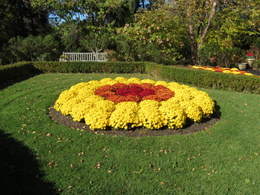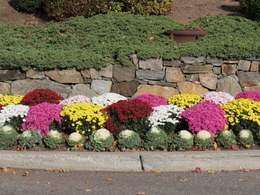Garden Mum
Growing Guide
Chrysanthemums (Chrysanthemum morifolium) may also be called mums, garden mums as well as hardy mums. They are a perennial native to China and grow well in USDA Zones 5 to 9 and prefer full sun.
When almost all other flowers are finished for the season, garden mums come to the rescue and provide us with a much-needed burst of color in the early fall. In the late summer they will show up in huge quantities in all of the garden centers as well as grocery stores.
Garden mums come in a wide variety of colors, which are long lasting and easy to care for. The National Chrysanthemum Society lists 13-classes of different types of flower forms.
Watering and Care
Most chrysanthemums are purchased during the late summer through fall. Some may be in full bloom, while others will have tight flower buds that are just a few days from opening. Hardy mums should be placed in a bright sunny location with the soil kept slightly moist. The potted mum should have drain holes and should not be left in standing water. Use a watering can to water the surface of the soil without getting the leaves wet to avoid fungal diseases.
If your mum pot is wrapped in shiny decorative foil you should remove it or make some holes in the bottom to let water drain out and into a saucer. If your mum is placed into a decorative pot check it after watering and empty it to avoid having to roots get waterlogged and begin to rot.
Toss or Keep?
As the fall season progresses your mum will start get a tired look. Most people will simply just toss it out. On the other hand it is a perennial and if you want it to be a permanent part of your flower garden you need to get it planted while the soil is still warm. Be sure to look for “hardy” or “garden mums” which can be grown as perennials.
Starting From Seed
Seeds can be started indoors 6 to 8-weeks before your last expected frost date. Follow the instructions on the seed package. For more guidance our seed starting page will be helpful.
You can direct sow mum seeds in your flower garden right after the last frost of the season. Mum seeds should be barely covered with soil since light helps aid in germination.
Soil Preparation
Plant your mums in full sun and in a nice loose well-drained garden soil and do best in a slightly acid soil with a pH range of 6.5 to 7.0.
When to Plant Mums
Mums will do best when planted in the spring, but it would be rare to find them then. Gardeners expect to buy plants when they are in bloom, which is in the late summer.
In many areas chrysanthemums will show up in the garden centers in August. Buy your mums as soon as you see them and plant them so that they get good root growth before the ground freezes. Giving them 3 months of root growth will almost guarantee success.
Planting too late is the most common reason for the mums as well as asters to die and not survive the winter.
Planting Chrysanthemums
Follow the grower’s instructions. They should be planted in full sun and how you plant them is also important. Use good garden soil that drains well and is a bit higher than the surrounding area. Mums do not like standing water and roots will quickly rot if left too wet.
Plant them 18 to 24-inches apart or in groups of 3 or 5 behind other shorter plants. Dig a hole as deep as the pot and twice as wide. To the soil you just removed add the same amount of good garden soil so you have a nice blend of new and native soil.
Take the plant out of the pot and gently loosen the root ball pulling away any roots that have grown in a circle around the pot.
Place the root ball in the hole with the growing crown of the mum even with the surrounding soil. Gently spread out the roots and back fill the hole around the root ball leaving a shallow depression around your plant. Fill the depression with water to settle the soil around the roots adding more soil if necessary and water again. Water daily tapering off as the mum roots grow and get established.
Watering and Care
Chrysanthemums are low maintenance and easy to care for. All you need to do is add a layer of mulch to help retain moisture and keep out competing weeds. Your mums should get an inch of water each week and during dry spells give some water to keep the soil moist. They usually do not need any fertilizer, but a light side dressing of organic fertilizer can be placed around the plant in the spring.
As the plant grows pinch back the growing tips at least 2 or 3-times. This will keep the plant more compact and encourage more branching and flower growth.
When the new growth is 4 to 6-inches long, clip off the top 1/2 to 1-inch of the new shoots. Do it again each time the new growth is 4 to 6-inches long again. Continue with the last time around the end of the first or second week of July.
From now on let the plant continue to grow and set the flower buds, which will bloom in the late summer along with the aster and sedum flowers.
They will look good until a few hard frosts hit and the leaves will turn brown and die. As part of your fall cleanup trim the dead stems to about 3 to 4-inches. After you get into the steady cold weather place some shredded leaves or pine straw over the plant to protect it from freezing and thawing, which could damage its roots. Branches or an old piece of carpet will help keep the mulch in place.
As spring approaches and the soil warms up, start removing the mulch cover which should be fully removed before the new shoots start growing.
To keep your plants vigorous divide them every 2 to 3-years in the spring. When new growth appears dig up the plant. Pull the clump apart and discard the oldest and replant the newest divisions 18-inches apart. You will now have many extra plants to expand your collection or give to your friends.
Diseases
Mums are relatively trouble-free, but leaf spot, rust, wilt and powdery mildew are the most common problems. Increasing air circulation around plants will help. Most diseases can be controlled with an organic product such as Bonide Copper Fungicide.
Overhead watering causes the leaves to get wet and helps spread these diseases. When watering only do it at the soil level keeping the leaves dry.
Inspect your plants often and remove any diseased or dead leaves from the plant as well as any that may have fallen on the ground. The fungi spores overwinter in plant debris. Keep a layer of mulch around the plants to keep the spores from splashing onto the plants from the soil.
Pests
Aphids and leaf miners are two major pests. The easiest way to deal with aphids without using chemicals is to knock them off with a spray of water. Ladybug beetles will eat many aphids. Many gardeners will purchase them and release them in their garden to help control the aphids that are a problem with many plants.
For organic gardeners with serious problems, Bonide insecticidal soap or neem oil can be used to control the aphids. Always read and follow the instructions on the label.
Leaf miners can be controlled by removing any affected leaves. Serious infestations can be controlled with an organic product containing spinosad such as Bonide Captain Jack's Dead Bug Brew.
Popular Varieties
Popular varieties: Autumn Bronze, Brandywine Sunset, Emperor of China, Hillside Sheffield Pink, Mammoth Daisy Coral, Mammoth Daisy Lavender, Mammoth Daisy Red, Mammoth Daisy Quill Yellow, Matchsticks, Painted Daisy, Peaches and Cream Primrose Gem, White Stars.
Sources: Burpee, Park Seed, Select Seeds.
Garden Spikes newsletters give you timely information once or twice a month. Subscribe Free to the Garden Times newsletter below.
Your email address will only be used to send you a newsletter and will never be sold. You can unsubscribe at any time.


